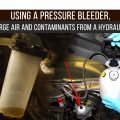Engine speed is measured like modern speedometers, by counting the frequency of the gear teeth driven by the engine, in this case, the starter motor gearwheel. Electrical control of the fuel injection is another improvement now adopted for modern engines. Overheating can be controlled by electronic monitoring of coolant temperature and regulating the engine power accordingly. Oil pressure can be monitored and used to regulate the engine power in a similar way.
Cooling
Like an automobile engine, the diesel engine needs to work at an optimum temperature for best efficiency. When it starts, it is too cold and, when working, it must not be allowed to get too hot. This consists of a water-based coolant circulating around the engine block, the coolant being kept cool by passing it through a radiator. The coolant is pumped round the cylinder block and the radiator by an electrically or belt driven pump.
The temperature is monitored by a thermostat and this regulates the speed of the radiator fan motor to adjust the cooling rate. When starting the coolant isn’t circulated at all. Some engines have fans with an electrically or hydrostatically driven motor. An hydraulic motor uses oil under pressure which has to be contained in a special reservoir and pumped to the motor.
It has the advantage of providing an in-built fluid coupling. Water freezes at 0°C or 32°F and frozen cooling water will quickly split a pipe or engine block due to the expansion of the water as it freezes. Some systems are self draining when the engine is stopped and most in Europe are designed to use a mixture of anti-freeze, with Gycol and some form of rust inhibitor. In the US, engines do not normally contain anti-freeze, although the new GM EMD H engines are designed to use it.
Problems with leaks and seals and the expense of putting a 100 gallons of coolant into a 3,000 hp engine, means that engines in the US have traditionally operated without it.
Lubrication
The oil gets heated by its passage around the engine and has to be kept cool, so it is passed through a radiator during its journey. The oil has to be filtered to remove impurities and it has to be monitored for low pressure. If oil pressure falls to a level which could cause the engine to seize up, a low oil pressure switch will shut down the engine. There is also a high pressure relief valve, to drain off excess oil back to the sump.
https://bit.ly/2k1NXGA
Cheers!
TEAM INNOVATION DISCOVERIES






2 Comments